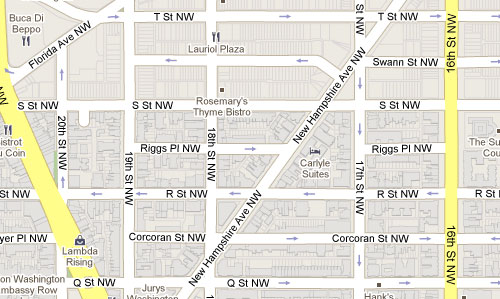Should Riggs Place get a speed hump?
The speed hump debate has come to Dupont Circle. Residents of the 1700 block of Riggs Place have applied for a speed hump, and neighborhood leaders are wondering whether to support it.
Riggs Place consists of three separate, short segments that don’t connect. The one in question is a two-block, one-way street from 19th Street to New Hampshire Avenue. According to residents of the portion east of 18th, cars speed along their block. We don’t have data on where they are going, though I suspect many may be circling for the scarce yet underpriced street parking during evenings and weekends.
Resident Jonas Morris and his neighbors have accumulated the requisite signatures to apply for a speed hump on their block. But mindful of the controversies that have surrounded similar applications in Chevy Chase DC and other areas, ANC 2B commissioners expressed trepidation about “opening the door” to a proliferation of speed humps across the neighborhood.
In Chevy Chase and Cleveland Park, we saw an escalating hump war where one block got speed humps, pushing traffic to other blocks, prompting those blocks to then themselves apply for speed humps. Some residents opposed other blocks’ applications, and others retaliated by honking as they drove along to annoy the residents who got humps. Would that happen in Dupont?
It’s possible it would not. Unlike Chevy Chase, Dupont has the wider lettered streets such as Q and R, and narrower named streets such as Corcoran and Riggs. Outside of the really major roads like Military, Chevy Chase’s sequence of named streets (Livingston, Morrison, McKinley, Northampton, etc.) are more alike. On the other hand, the minor streets already get lower traffic volumes, especially the dead-end blocks. Is it appropriate to further restrict traffic on those streets at the expense of those living on the larger, yet still residential lettered streets?
Would a speed hump even fix the problem? It’s not like through traffic uses Riggs, since it doesn’t go anywhere. It would be helpful to understand who is speeding there, and why. When I lived a block from there, the only time I would drive on that block was to try to park.
If the high-speed traffic is people circling for parking, a speed hump won’t deter them. They may well just speed down the road until they reach the speed hump, slow down to traverse it, then speed up again, since drivers looking for parking are often in a hurry to get the car parked or to find that elusive space before someone else does.
A metered parking system for non-residents on residential streets in Dupont could better alleviate this problem by actually reducing circling. If Riggs’ spaces, along with R’s, S’s, Swann’s and so on, weren’t free for unlimited time periods evenings and weekends, people could more quickly find spaces instead of winding through the neighborhood’s minor roadways when eating at Lauriol Plaza, a major attractor of drivers in that area.
Another option might be to make this block two-way. It looks like this block is a little wider than the block immediately to the west. The 1600 block, which doesn’t connect to this one, is two-way, but also apparently quite narrow.
If we understood the source of the problem, we could better determine whether a speed hump would fix it, simply incite drivers to speed up and slow down, or push traffic to other roads. Maybe a speed hump is the right answer. It’s a relatively cheap type of traffic calming. But maybe it’s not. What do you think?


